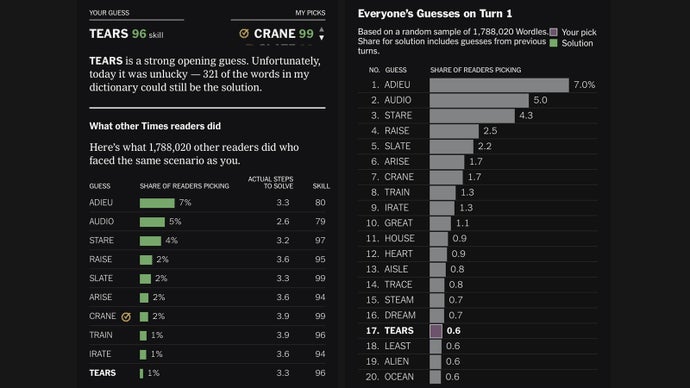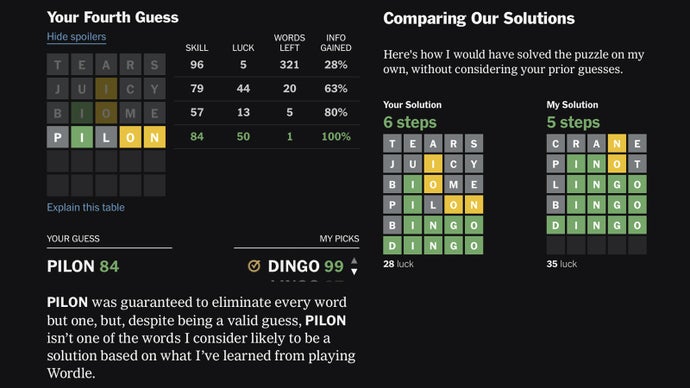After completing this morning’s Wordle I found myself drawn to a “New!” link advertising WordleBot, a smart-sounding addition to The New York Times app which promised to analyse my puzzle solution and compare it with others. (I got today’s word in six, for which I’m still feeling a little shameful.)
Scrolling through its results I was impressed – not only does WordleBot show how other players began today’s game and then narrowed down the solution over subsequent guesses, it also shows how WordleBot itself, programmed with a set of rules and likelihoods, fared too. (WordleBot only got today’s word after five guesses, which immediately made me feel a little better.)
This was my first experience of WordleBot, a program I now understand has existed for some time online, but has only this week been added to the New York Times puzzle app – where I play a set routine of Wordle, the Mini Crossword and then (if I’m not running too late by this point) Connections as well.
Writing back in 2022, The New York Times described its work-in-progress Wordlebot as “the tool that sometimes uplifts you when you think your Wordle performance has been terrible, and sometimes chides you when you think you’ve played superbly”. And after a pretty poor six-guess run today, I do feel a little better.
To begin with, Wordlebot says my starting guess was strong – but unlucky with today’s word. I always pick TEARS, which is a relatively popular choice in the grand scheme of things (a subsequent screen tells me it’s 17th out of all possible starting words, though most people pick either ADIEU or AUDIO.

Wordlebot always starts with CRANE, a word The New York Times has chosen specifically and has changed over time (it used to be TRACE, and in hard mode is now TROPE). Interestingly, though, Wordlebot’s CRANE was an even tougher pick today, requiring 3.6 guesses to solve versus TEARS’ 3.3. (So, at least at that point, I should have beaten Wordlebot! Darn.)
Spoiler warning: From here on out, we show the solution to today’s Wordle puzzle. Beware!

Delving on through each guess, I came to my fourth attempt – PILON – which I’m pretty sure was me just trying random placements for the vowels at this point and not expecting anything to work. Wordlebot is impressed by my knowledge of the word, though happy to tell me it was probably too obscure to be a likely result. Hard agree!
After an unlucky start and some mid-game stumbles, I’m cheered to see Wordlebot also went for BINGO before the ultimate answer DINGO, which I initially discounted for being too obscure to Americans. Ah, well. But, as mentioned, WordleBot still took only one fewer guess to arrive at the right result. It feels like today was a tricky one in general?
All in all, it’s fascinating stuff – and something I’m going to use in future as I play. One downside, though – after your first look, Wordlebot reveals itself to be a paid-for feature, so you’ll need to stump up £2.99 a month from here on out for more. But hey, if it helps you feel better about your results – and I think I need do – then maybe give it a try?
